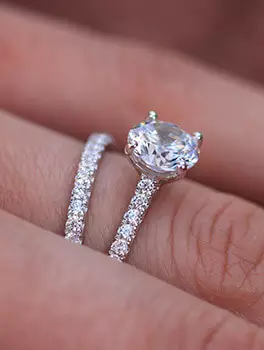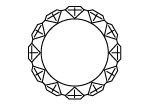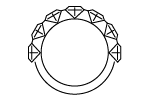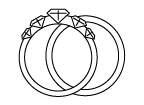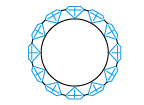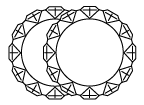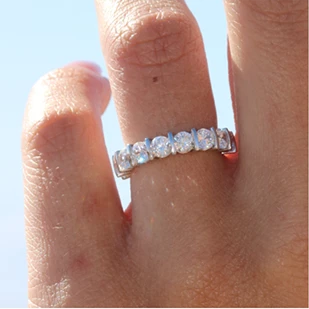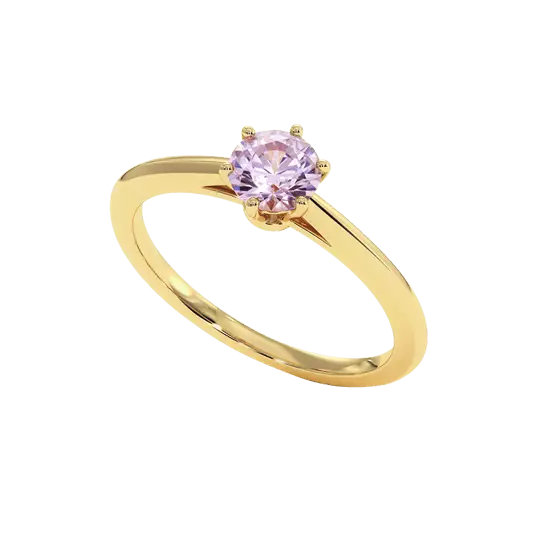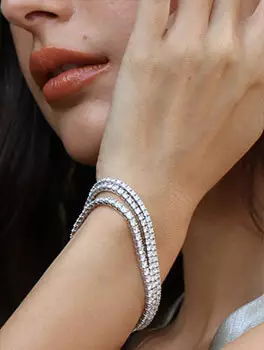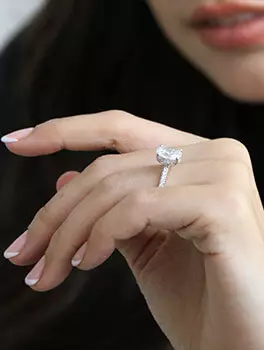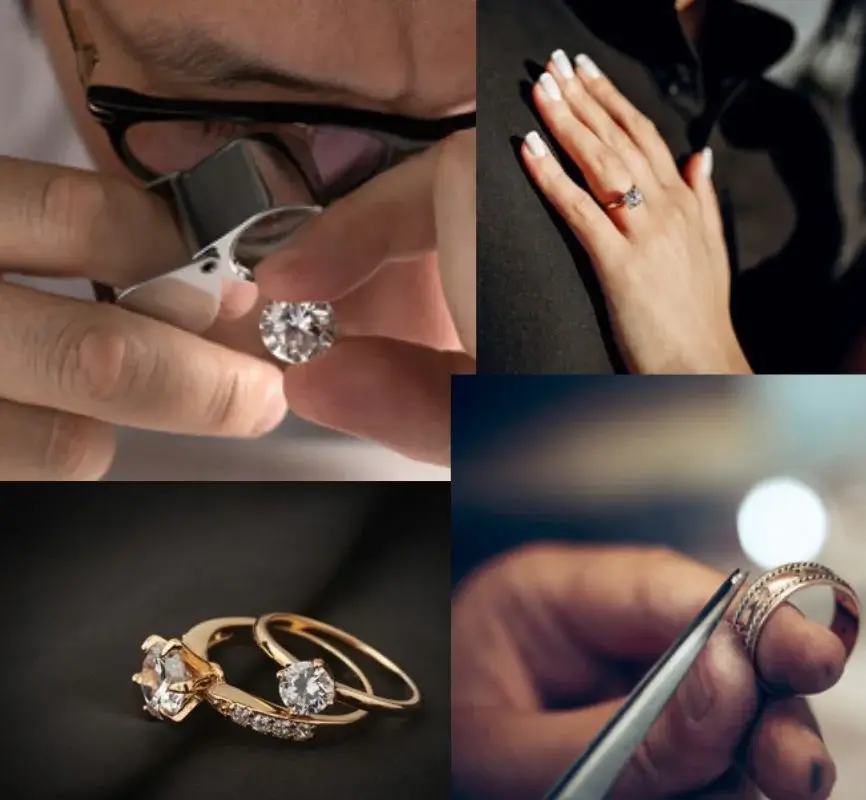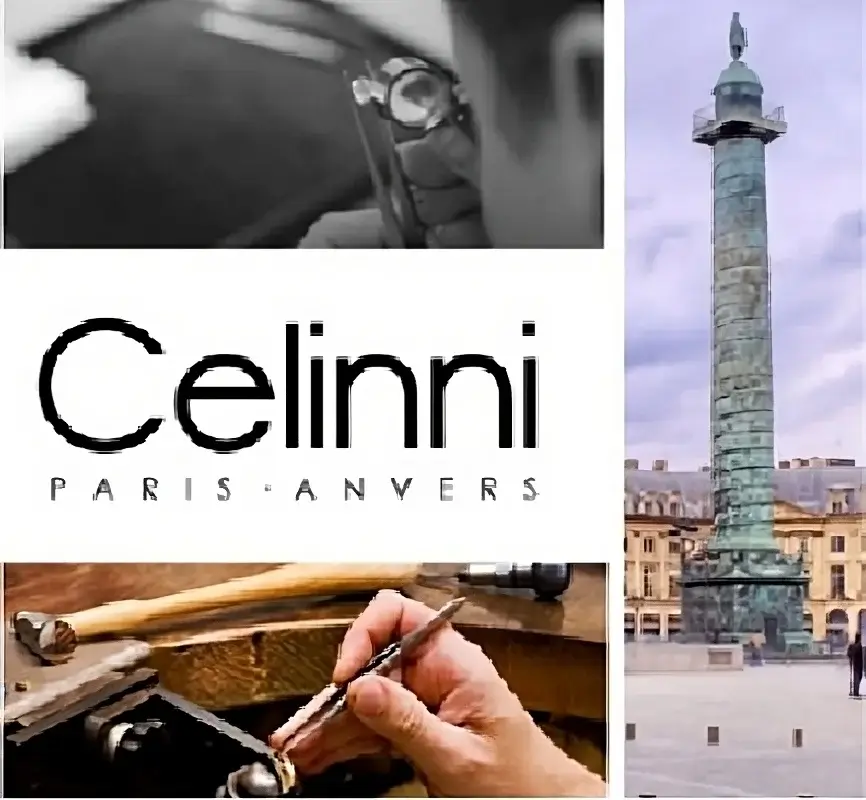DIAMOND GUIDE
Learn and understand to buy a natural diamond with full awareness!
Is the diamond a mystery to you? Here are the 22 fundamental questions that will allow you to choose a diamond to make a piece of jewelry or to start a collection.
WHAT IS THE COMPOSITION OF DIAMOND?

A diamond is a rare mineral composed exclusively of carbon that has been subjected to high pressures and high temperatures underground.
The diamond is extracted from a rock called Kimberlite that comes from magma. The composition of the diamond at its base seems quite simplistic while the steps of its creation make it a very rare material.
WHAT IS THE LIFE CYCLE OF A DIAMOND?
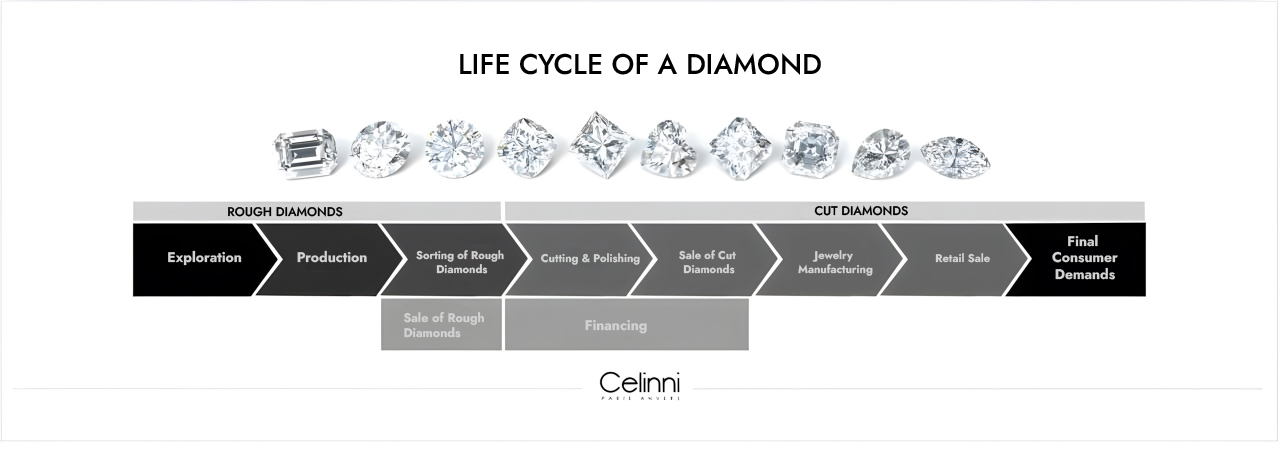
Natural diamonds are mined primarily in South Africa, Botswana, Namibia, Canada, and Russia. Rough diamonds are mainly marketed in Antwerp and then exported to India to be transformed into gems for jewelry use. 12 out of 15 diamonds are cut in Surat.
The cut diamonds are entrusted to the gemology laboratory for certification and then exported to the various diamond exchanges.
Understanding the life cycle of a diamond will allow you to consciously purchase the ideal stone!
IS THE DIAMOND UNBREAKABLE?

The diamond is the hardest material known in our world. It has a hardness of 10 on the Mohs scale, which is the hardness scale for minerals.
While a diamond can only be scratched by another diamond, it can break if it undergoes a significant shock.
WHAT IS THE MEANING OF THE 4CS OF THE DIAMOND?

The 4Cs of the diamond represent the 4 main evaluation criteria of the diamond. We talk about 4C because they are the initials of the 4 main characteristics:
- Carat: weight of the diamond
- Color: color of the diamond
- Clarity: clarity of the diamond
- Cut: quality of the diamond cut
WHAT IS THE CARAT?
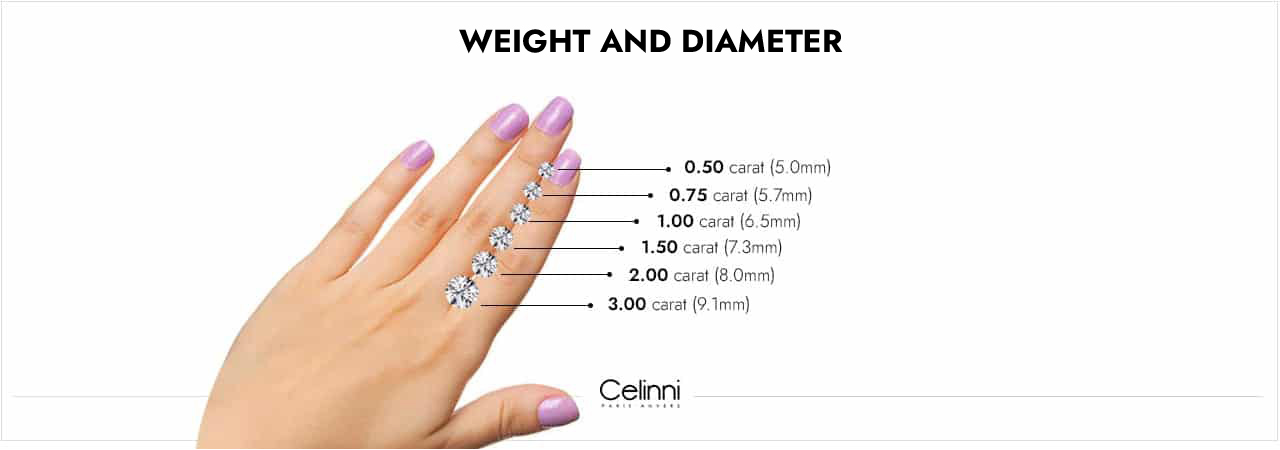
The weight of the diamond is the first quality criterion of a diamond. The term carat (ct) refers to the Carob seed from a tree called "Carob". This seed, which always weighed the same, was used as a reference during antiquity to weigh gems.
This ancient unit of measurement weighed 0.20 gram, which is the weight of a carat for a diamond. The weight determines the size of the diamond.
1 carat is equivalent to 0.20 gram and can be broken down into 100 points or 100 hundredths. 0.50 carat is therefore equivalent to 50 points or ½ carat.
The average diameter of a one carat round diamond is 6.2 mm and that of a 0.50 carat round diamond is 5.0 millimeters.
Check out our complete article on the diamond carat to learn more.
WHAT IS THE COLOR OF A DIAMANT?
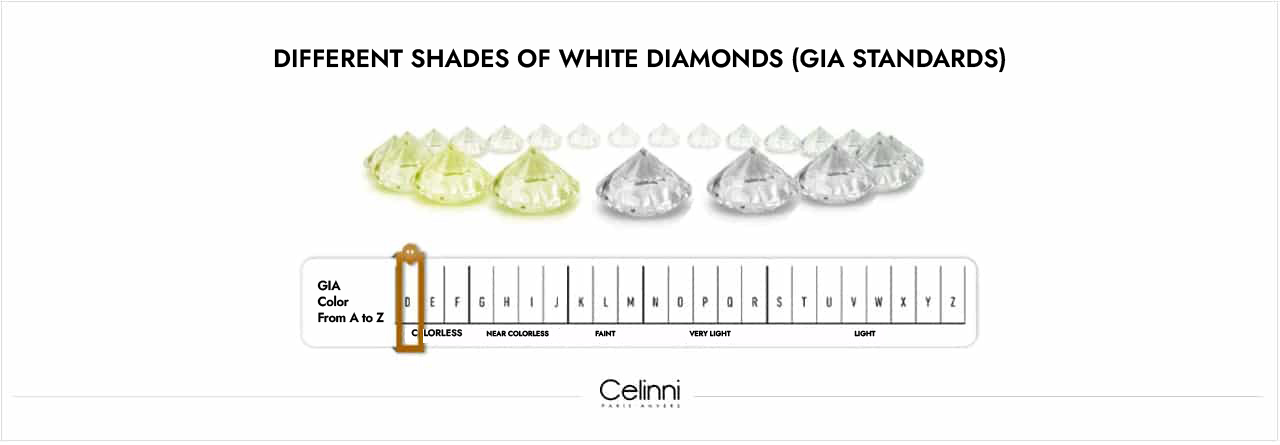
Diamonds exist in all colors. The rarest and most sought-after diamonds are those with no color, no hue, they are then said to be colorless or exceptional white +.
The color of the white diamond is evaluated on a color scale of the Gemological Institute of America (GIA) which ranges from exceptional white + to very pale yellow (Color classification from letter D to letter Z).
Very rare, diamonds classified as letter D are the most devoid of color, while G and H color diamonds are respectively extra white and white. The letter Z characterizes a light yellow or brown diamond.
The positioning of a diamond on the scale of shades of white can only be done by specialists under specific light and only on unmounted diamonds.
To find a quality diamond, visit our catalog of certified diamonds by different laboratories such as the GIA, HRD or IGI.
Read our complete article on the color of the diamond to learn more.
WHAT IS THE PURITY OF A DIAMOND?

Diamonds exist in all colors. The rarest and most sought-after diamonds are those with no color, no tint, they are then said to be colorless or exceptional white +.
The color of the white diamond is evaluated on a color scale of the Gemological Institute of America (GIA) which ranges from exceptional white + to very pale yellow (Color classification from letter D to letter Z).
Very rare, diamonds classified as letter D are the most devoid of color, while G and H color diamonds are respectively extra white and white. The letter Z characterizes a light yellow or brown diamond.
The positioning of a diamond on the scale of shades of white can only be done by specialists under specific light and only on unmounted diamonds.
To find a quality diamond, visit our catalog of diamonds certified by various laboratories such as the GIA, the HRD or the IGI.
Check out our complete article on diamond color to learn more.
What is the purity of a diamond?
The purity of a diamond is determined after evaluating small internal imperfections and on the surface. Surface imperfections are called surface defects, and internal defects are called inclusions. Many inclusions are not visible to the naked eye.
To determine the purity of a diamond, the expert observes it with a 10x magnifying loupe.
Determining the purity of the diamond requires expertise and an experienced eye.
The purity of a diamond is determined by: the number of inclusions, the type of inclusion, and the size of these present in the diamond.
The purity of a diamond is classified on the purity scale of the Gemological Institute of America:
- FL – Flawless: no defect IF – Internally Flawless: no internal defect
- VVS1, VVS2 – Very Very Slightly Included: inclusions hardly visible with a 10x loupe
- VS1, VS2 – Very Slightly Included: inclusions visible with a 10x loupe, but not to the naked eye.
- SI1, SI2, SI3 – Slightly Included: inclusions hardly visible to the naked eye (if center of the stone is clean)
- I1, I2,I3 – Included: inclusions visible to the naked eye
In practice, an untrained eye will not see inclusions before the I1 level. The place of inclusions is also decisive in the purity of the diamond. The fewer imperfections the diamond has, the higher its financial value will be.
Check out the complete guide to diamond purity to learn more.
WHAT DOES THE CUT OF THE DIAMOND MEAN?

The quality of the cut will determine the fire, brilliance, and sparkle of the diamond. This characteristic is one of the most important of the 4 Cs, as it is the one that most impacts the sparkle of a diamond. If the diamond's cut is not successful, it will appear dull and smaller than it is.
A perfect cut is essential for a perfect reflection of light rays through the diamond. This is the only diamond classification criterion that involves human intervention. First proposed in 1919 by mathematician Tolkowsky, the round or brilliant cut is optimal for the diamond's brilliance.
To evaluate the cut of the round diamond, the diamond cutter will have to consider three criteria:
- The polish: the polish allows to detect possible polishing streaks, scratches or chips. It is evaluated by observing the surface of the facets.
- The symmetry: the estimation of the symmetry results from the observation of the good meeting of the facets, the presence of additional facets and significant naivety, the centering of the culet and the table as well as the symmetry of the facets.
-The proportions: the proportion determines the balance between the different elements of the stone namely the table, the crown, the girdle and the pavilion.
These elements must have a perfect balance to reflect light optimally.
Check out our complete article on the diamond cut to become a true expert!
WHAT IS THE FLUORESCENCE OF A DIAMOND?
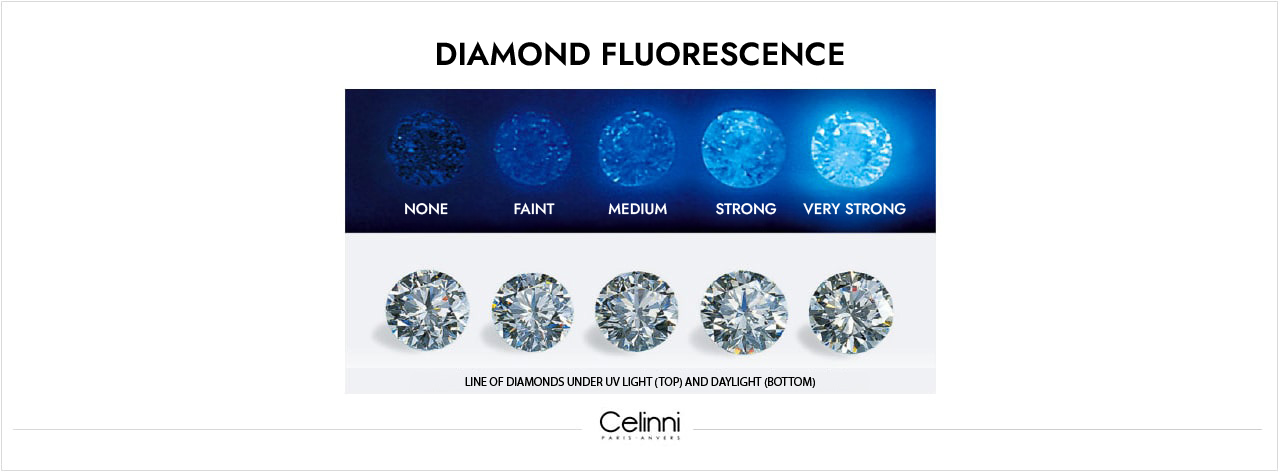
Extracted from a mine or a river, so-called fluorescent diamonds contain particles that emit a visible glow when exposed to UV lighting. This fluorescence comes from a reaction between the energy of the light and the atoms of the diamond.
This characteristic is caused by the presence of nitrogen and other impurities in the diamond's crystalline structure.
The glow emitted can be of different colors, the most common being blue.
The fluorescence of a diamond is indicated on diamond certificates. One of the following mentions is written: "none" for absence of fluorescence; "faint" or "very faint" for slight fluorescence; "medium" for medium fluorescence; "strong" for significant fluorescence.
In very high shades D, E, and F, strong fluorescence is less desirable because elle can slightly impair transparency. On the other hand, in "low" colors, from I, strong fluorescence is desirable because elle will give a bluish light preferable to the original yellow or brown hue.
The fluorescence of a diamond is rarely a determining factor in the choice of a diamond. However, elle plays a very important role in the price of the gem.
WHAT ARE THE DIFFERENT SHAPES OF CUT DIAMONDS?

Although the brilliant round diamond cut is the most popular, there are also fancy cuts:
- The marquise diamond cut: also called the navette cut, the marquise diamond cut is said to have originated from the Marquise Pompadour for whom Louis XV had a diamond cut to resemble her smile. It is elongated in shape and usually has 58 facets.
- The pear diamond cut: usually composed of 58 facets as well, the pear cut is a hybrid diamond cut combining both the round and marquise cuts. The pear diamond cut can also be referred to as the teardrop cut.
- The heart diamond cut: romantic, the heart diamond cut usually has between 56 and 58 facets. However, the appearance of the heart cut can slightly differ depending on the brand or structure.
- The oval diamond cut: the oval diamond cut is ideal for elongating shorter fingers. Composed of 58 facets, the oval diamond cut can be used as the central stone of a ring or be set as surrounding stones.
- The emerald diamond cut: the emerald diamond cut gets its name from the cut of the emerald stone. The emerald cut requires a diamond of great purity. The emerald diamond cut usually has 57 facets.
- The princess diamond cut: the princess diamond cut is the most brilliant of the square diamond cuts. This increased sparkle is ensured by its 76 facets. The width of the table of the princess cut also requires good purity.
- The radiant diamond cut: the radiant diamond cut is a unique and hybrid diamond with 70 facets and distinctive cut edges. The radiant cut hides inclusions more effectively than other shapes.
- The cushion diamond cut: it is a square or rectangular diamond with polished edges. It is one of the most brilliant and popular shapes in high-end jewelry.
Read the full article on the different shapes of cut diamond to choose your future diamond.
WHY CERTIFY A DIAMOND?

The importance of the gemology laboratory becomes clear when it comes to controlling the quality of a diamond. It is the third party of trust between the professional and the consumer. The three main certifying bodies are the GIA, The HRD or the IGI laboratory. There are other serious laboratories such as the AGS in the USA, which are little used on the European market.
Consult the article on the 3 major diamond certification laboratories to understand the steps and methods of creating a certificate.
WILL THE EXPERTISE OF TWO DIFFERENT LABORATORIES GIVE THE SAME RESULT FOR THE SAME STONE?

Experience shows that if the same diamond is given to be certified in different organizations, the result can change depending on the laboratory. We have even noticed that there are cases in which the same diamond certified by the same laboratory a few months apart can slightly see its expertise being different.
Part of the evaluation criteria being carried out by humans, it is possible that perception changes depending on the lab technician.
Understanding the differences between diamond certificates will allow for a factual evaluation of a diamond's value.
WHY A LASER ENGRAVING ON A DIAMOND?

It is important to be able to use the magnifying glass or microscope to appreciate the certificate number that is engraved on one of the facets of the diamond. It will be the guarantor of the conformity between the material and the official documents issued by the certification body. There are about ten recognized diamond laboratories in the world that make diamond engraving tamper-proof.
WHY GET A CERTIFIED APPRAISAL REPORT WHEN BUYING A DIAMOND?

The expert report is a document that allows you to value your diamond. It indicates the value of the diamond in the retail jewelry trade.
Do not be surprised when your expert certificate shows a value higher than that of your invoice because it is simply due to the fact that the Celinni is primarily a wholesaler offering you rates well below traditional jewelry trade.
The insurance certificate will allow you to insure your diamond with your company and make the right choices when transferring your assets.
WHY CHOOSE A DIAMOND FROM Celinni?

The brilliance of a diamond is determined by two factors:
- The quality of the rough diamond
- The way the stone is cut
The diamonds of the Celinni© are renowned for their quality and brilliance. The raw materials are carefully selected to provide customers with superior quality diamonds.
Discover in detail why choose a diamond from Celinni?
WHAT IS A PERFECT DIAMOND?
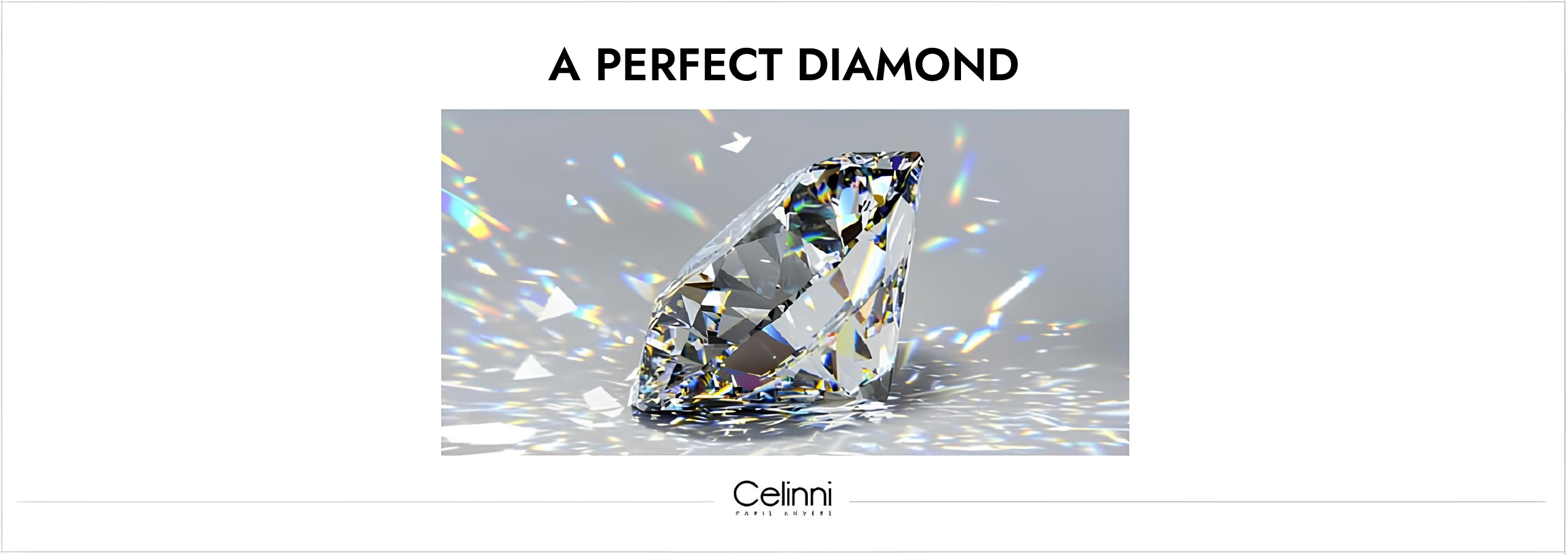
The best quality of diamond is as follows :
- Color : D (exceptional white +)
- Clarity : FL (Flawless)
- Cut : excellent
- Symmetry : Excellent
- Polish : Excellent
- Fluorescence : None
These diamonds are very rare and very expensive.
A perfect diamond has the best results in all the categories that make up its nomenclature.
WHAT IS THE PRICE OF A DIAMOND?
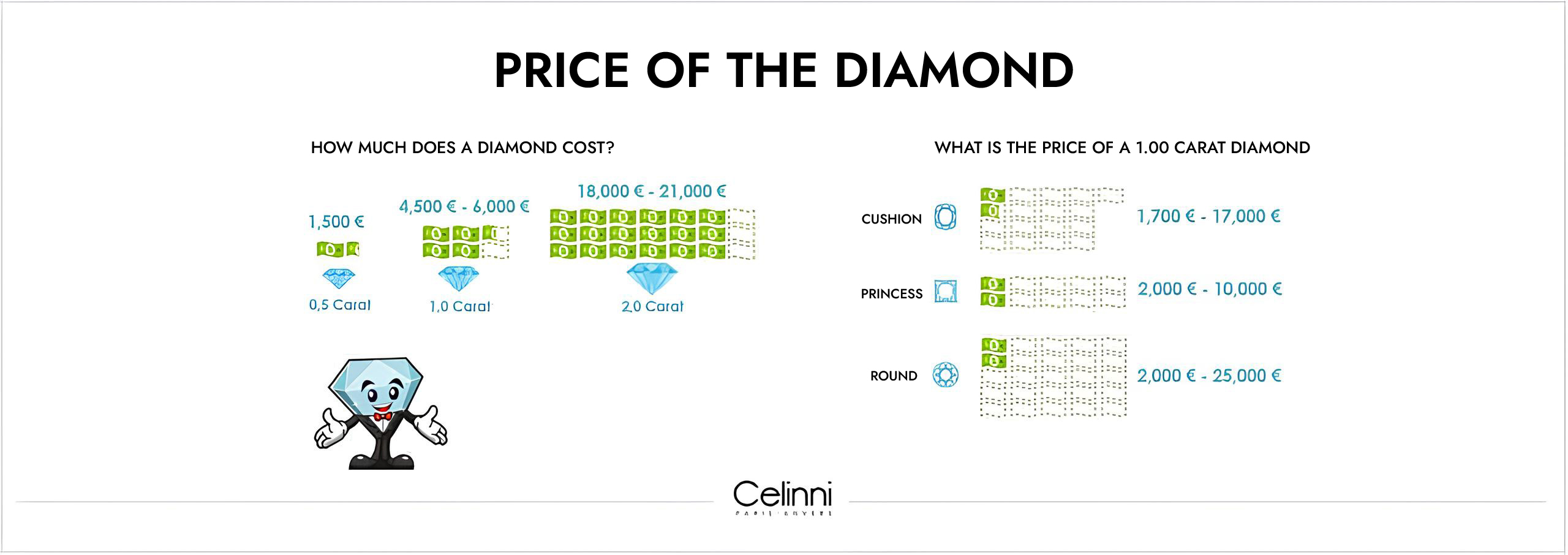
Updated on August 16, 2022 - Next update October 01, 2022
The value of a diamond depends on a number of important criteria that you will find on our dedicated page to the price of diamonds. These criteria include the 4Cs (carat weight, clarity, cut, and color) and other factors are taken into account such as polish, symmetry, fluorescence or even diamond shape. In the professional field, prices are given in weight per carat.
The update of the Rapaport (diamond price) is dated Monday, August 01, 2022 and it has decreased on average by 1.4% compared to the month of July. This is a small good news for buyers who have seen the price skyrocket over the past 12 months.
Average diamond price per carat depending on weight
| Average Weight | Average Price per Carat |
|---|---|
| Less than 0.50 ct. | €2,030 |
| 0.51 to 0.99 ct. | €3,370 |
| 1.00 to 1.49 ct. | €6,190 |
| 1.50 to 1.99 ct. | €9,040 |
| 2.00 to 2.99 ct. | €12,680 |
| 3.00 to 3.99 ct. | €17,200 |
| 4.00 to 4.99 ct. | €21,970 |
| 5.00 ct. And more | €30,160 |
These prices are given as an indication to give you a snapshot of the current market.
They are calculated based on the current supply and demand by carat weight group.
WHY ARE NATURAL COLORED DIAMONDS EXPENSIVE?
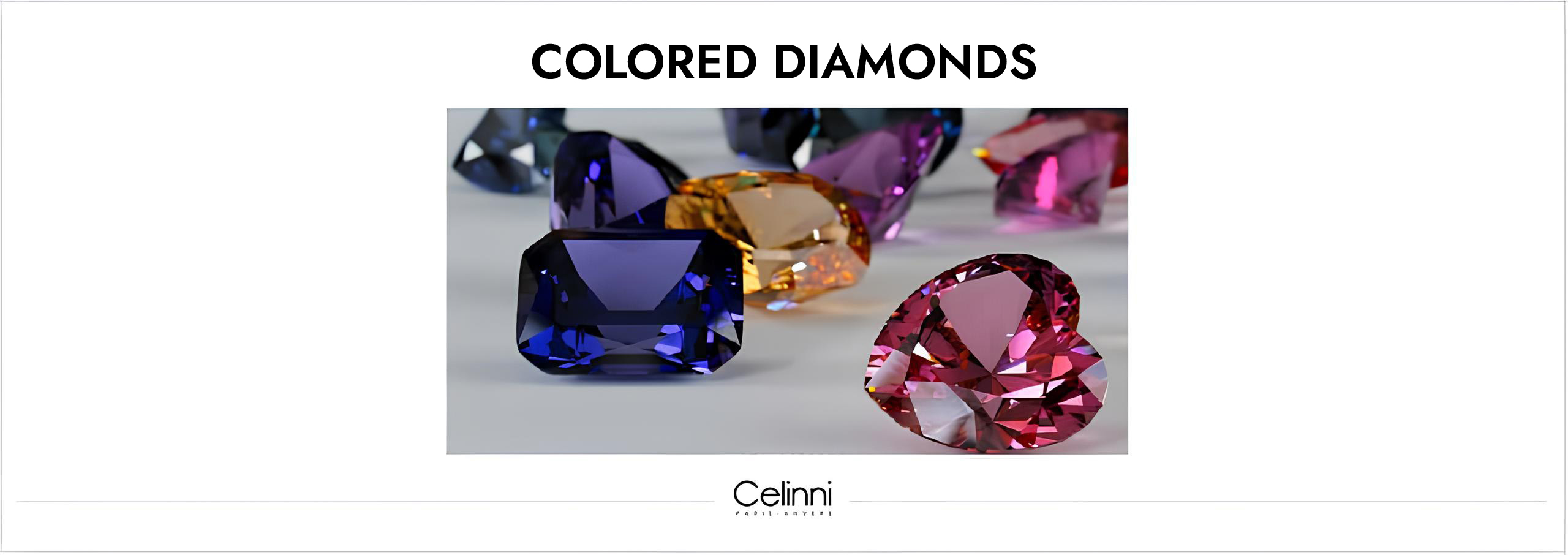
A colored diamond is a diamond that goes beyond the traditional color spectrum from white to 'less white'. There are 27 identified shades such as yellow, red, green, purple or even pink. Their extreme rarity makes them unique pieces coveted by collectors. To acquire a colored diamond naturally, you must go to a diamond specialist in contact with the production sites.
WHAT ARE THE FAMOUS DIAMONDS?

There are exceptional diamonds due to their importance and rarity that have become known over the years. Each has a more or less pleasant story.
The most famous are: The Cullinan diamond, The Great Star of Africa diamond, The Hope diamond, The Koh-i-Noor diamond, The Golden Jubilee diamond, The Orloff diamond, The Regent diamond, The Sancy diamond.
HOW TO BECOME A DIAMOND DEALER?

To become a diamond dealer, it is advisable to study gemology. The most reputable organizations are the ING in Paris, the HRD institution in Antwerp, and the GIA association in the USA.
You will need to learn about diamonds in all their facets initially from a technical point of view. Then, it will be fundamental to learn about the market by doing internships in France or abroad.
Being a diamond dealer is a fascinating profession that allows you to discover wonderful cultures on a daily basis.
WHAT IS THE AVERAGE SPENDING BUDGET FOR A DIAMOND?
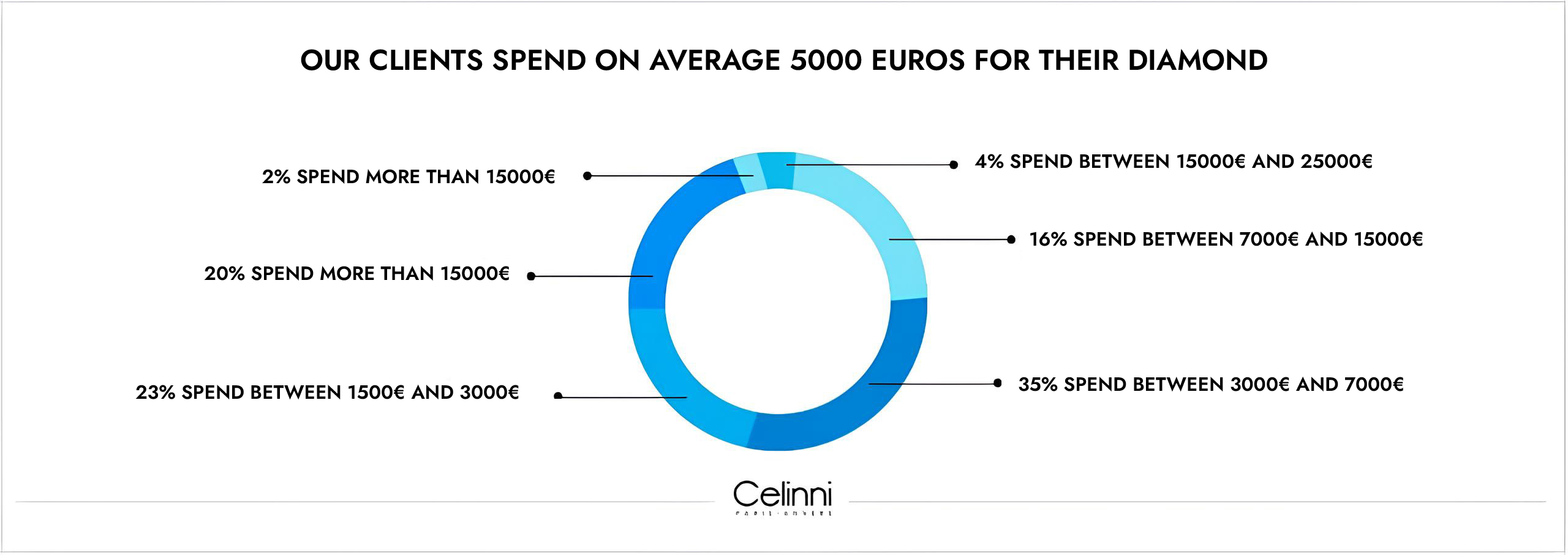
We talk about investment diamonds when we buy diamonds in order to keep them in the hope of securing or making a profit on our investment.
Experience shows us that over the past 30 years the price of diamonds has been constantly increasing and that as part of a diversification of investments, it can be interesting to own a few diamonds. In a dynamic of investment diamonds, we advise working with stones between 0.50 and 1.50 carats with the best 4C indices.
Important warning: we do not consider diamonds as an investment material but only as a diversification of investment.
What is a diamond?
A diamond is a mineral composed of pure carbon. It is the hardest natural material known on our planet; it is also the most popular of gems. Due to its extreme hardness, diamonds have a significant number of industrial applications.
How much does a diamond cost?
The average price of a one carat diamond is 6200 euros, that of a 1.50 carat diamond is 9000 euros and diamonds starting from 2.00 carats begin at 12600 Euros.
How to appraise a diamond?
Most jewelry stores offer appraisals. They usually have an expert on their team. You can contact the jewelry store in advance to make an appointment and have your jewelry appraised in front of you. You can also entrust your jewelry to an independent appraisal laboratory.








NEWSLETTER
Sign up to receive the latest news regarding
the products and services CELINNI, and much more.






















